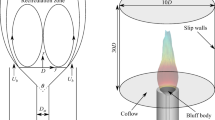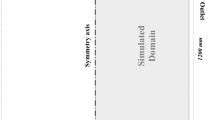Abstract
The objective of this work is to assess the performances of different turbulence models in predicting turbulent diffusion flames in conjunction with the flamelet model.The k–ε model, the Explicit Algebraic Stress Model (EASM) and the k–ε model withvaried anisotropy parameter C μ (LEA k–ε model)are first applied to the inert turbulent flow over a backward-facing step, demonstrating the quality of the turbulence models. Following this, theyare used to simulate the CH4/H2 bluff-body flame studied by the University of Sydney/Sandia.The numerical results are compared to experimental values of the mixture fraction, velocity field, temperature and constituent mass fractions.The comparisons show that the overall result depends on the turbulence model used, and indicate that theEASM and the LEA k–ε models perform better than the k–ε model and mimic most of the significant flow features.
Similar content being viewed by others
References
Abid, A., Rumsey, C. and Gatski, T., Prediction of nonequlibrium turbulent flows with explicit algebraic stress models. AIAA J. 33 (1995) 2026–2031.
Craft, T., Launder B.E. and Suga, K.A., A non-linear eddy-viscosity model including sensitivity to stress anisotropy. In: Proceedings of 10th Symposium on Turbulent Shear Flows. Pennsylvania State University (1995) Session 23, pp. 19–24.
Driver, D.M. and Seemiller, H.J., Features of a reattaching turbulent shear layer in a divergent channel flow. AIAA J. 23 (1985) 163–171.
Gatski, T.B. and Speziale, C.G., On explicit algebraic stress models for complex turbulent flows. J. Fluid Mech. 254 (1993) 59–78.
Hallbäck, M., Johansson, A.V. and Burden, A.D., The basic of turbulence modelling. In: Hallbäck, M., Henningson, D.S., Johansson, A.V. and Alfredsson P.H., (eds.), Turbulence and Transition Modelling. Kluwer Academic Publishers, Dordrecht (1996) pp. 81–145.
Jischa, M., Konvektiver Impuls-, Wärme-und Stoffaustausch. Grundlagen der Ingenieurwis-senschaften, Vieweg, Braunschweig/Wiesbaden (1982).
Jones, W.P. and Whitelaw, J.H., Calculation methods for reacting turbulent flows: A review.
Kim, J.S. and Williams, F.A., Structures of flow and mixture-fraction fields for counterflow diffusion flames with small stoichiometric mixture fractions. SIAM J. Appl. Math. 53 (1993) 1551–1566.
Peters, N., Laminar diffusion flamelet models in non-premixed turbulent combustion. Prog. Energy Combust. Sci. 10 (1984) 319–339.
Peters, N., Turbulent Combustion. Cambridge University Press, Cambridge (2000).
Pitsch, H., Chen, M. and Peters, N., Unsteady flamelet modeling of turbulent hydrogen/air dif-fusion flames. In: 27th Symposium (International) on Combustion. The Combustion Institute, Pittsburgh (1998) pp. 1057–1064.
Pitsch, H., Riesmeier, E. and Peters, N., Unsteady flamelet modelling of soot formation in turbulent diffusion flames. Combust. Sci. Tech. 158 (2000) 389–406.
Pope, S.B., A Monte Carlo method for the PDF equations of turbulent reactive flow. Combust. Sci. Tech. 25 (1981) 159–174.
Pope, S.B., PDF Methods for turbulent reactive flows. Prog. Energy Combust. Sci. 11 (1985) 119–192.
Rhie, C.M. and Chow, W.L., Numerical study of the turbulent flow past an airfoil with trailing edge separation. AIAA J. 21 (1983) 1325–1332.
Rodi, W., A new algebraic relation for calculating the Reynolds stresses. Z. Angew. Math. Mech. 56 (1976) 219–221.
Rung, T., Thiele, F. and Fu, S. On the realisability of non-linear stress-strain relationships for Reynolds-stress closures. Flow, Turbulence Combust. 60 (1999) 333–359.
Speziale, C.G., Sarkar, S. and Gatski, T.B., Modelling the pressure–strain correlation of turbulence:an invariant dynamical systems approach. J. Fluid Mech. 227 (1991) 245–272.
Sutherland, D.M., The viscosity of gases and molecular forces. Philos. Mag. Ser. 36(5) (1893) 507–530.
Author information
Authors and Affiliations
Rights and permissions
About this article
Cite this article
Yan, J., Thiele, F. & Buffat, M. A Turbulence Model Sensitivity Study for CH4/H2 Bluff-Body Stabilized Flames. Flow, Turbulence and Combustion 73, 1–24 (2004). https://doi.org/10.1023/B:APPL.0000044318.99203.bd
Issue Date:
DOI: https://doi.org/10.1023/B:APPL.0000044318.99203.bd




